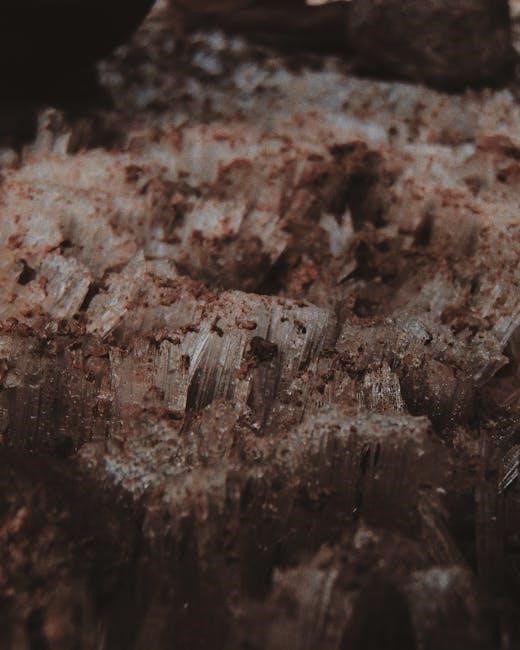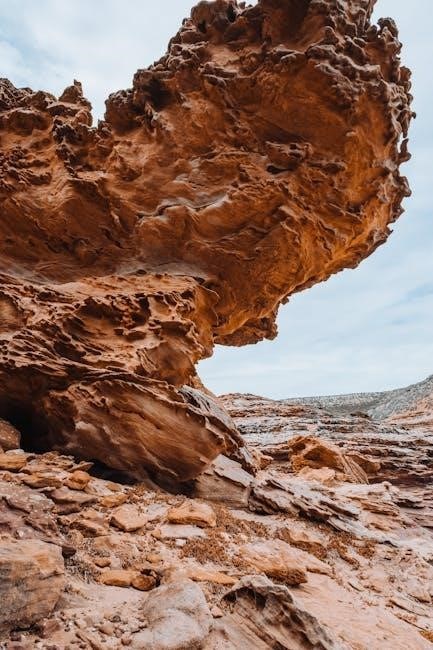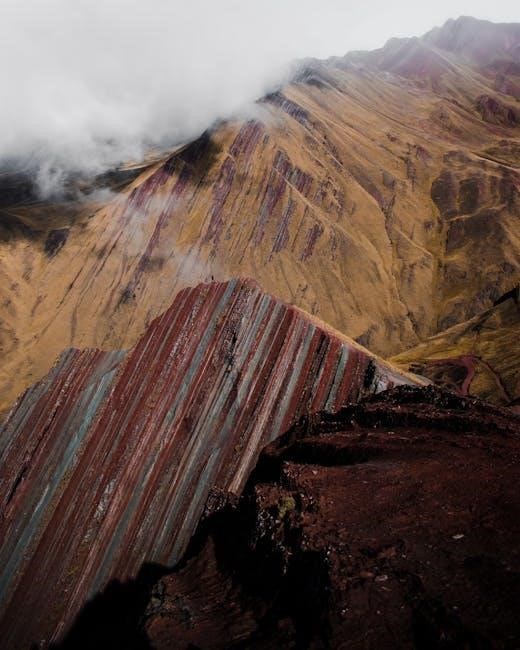Discover the Earth’s structure with engaging worksheets designed for students of all grades. These resources include labeling, coloring, and question activities, complete with answer keys for easy assessment. Perfect for enhancing geology lessons, they cater to various learning styles and provide a fun way to explore the Earth’s layers.
What Are the Layers of the Earth?
The Earth is composed of four distinct layers: the crust, mantle, outer core, and inner core. The crust, the outermost layer, is the solid surface we live on and varies in thickness. Beneath it lies the mantle, the thickest layer, made of hot, viscous rock. The outer core is a liquid layer of metal, primarily iron and nickel, generating Earth’s magnetic field. The inner core is the hottest and densest layer, a solid metal center. These layers differ in composition, temperature, and density, forming the complex structure of our planet. Understanding these layers is essential for geology and Earth science studies.
Why Use Worksheets for Learning the Earth’s Layers?
Worksheets are an effective tool for teaching the Earth’s layers, offering interactive and visual learning experiences. They cater to different learning styles, making complex concepts accessible. Activities like labeling diagrams, coloring, and answering questions enhance retention and understanding. Worksheets also provide a structured format for students to organize their knowledge. Additionally, the inclusion of answer keys allows teachers to assess progress efficiently. These resources are ideal for engaging students and reinforcing lessons on the Earth’s structure, making them a valuable addition to any geology or science curriculum.

Importance of Understanding the Earth’s Layers
Understanding the Earth’s layers is crucial for grasping geological processes, natural phenomena, and environmental changes. It enhances scientific literacy and fosters curiosity about our planet’s structure and dynamics.
Key Features of the Layers of the Earth Worksheet Answer Key
The Layers of the Earth worksheet answer key offers a comprehensive learning tool for students. It includes labeled diagrams, coloring activities, and multiple-choice questions to engage learners. The answer key provides clear solutions, making it easy for teachers to assess student progress. Features like fill-in-the-blank exercises and short-answer questions encourage critical thinking. Visual aids, such as cross-sectional diagrams of the Earth, help students visualize the crust, mantle, outer core, and inner core. The worksheet also includes fun activities, like the “Layered Candy Bar” project, to make learning interactive. These resources cater to diverse learning styles, ensuring a deeper understanding of Earth’s structure.
How Worksheets Help Students Grasp Geographical Concepts
Worksheets are an effective tool for teaching students about the Earth’s layers, offering hands-on activities that enhance understanding. Labeling diagrams, coloring exercises, and short-answer questions engage students, making learning interactive. These resources cater to different learning styles, ensuring retention and comprehension. Worksheets also include answer keys, allowing teachers to assess progress easily. Activities like the “Layered Candy Bar” project provide a tangible way to visualize Earth’s structure. By combining visual, tactile, and written exercises, worksheets help students build a strong foundation in geological concepts, fostering curiosity and a deeper appreciation for Earth’s composition.
Structure of the Earth
The Earth is composed of four distinct layers: the crust, mantle, outer core, and inner core. The crust is the thinnest, outermost layer, while the mantle is the thickest, made of hot rock. The outer core is a liquid metal layer, and the inner core is a solid, extremely hot center.
The Crust: The Outermost Layer
The crust is the Earth’s outermost layer, ranging in thickness from 5 kilometers beneath the oceans to approximately 50 kilometers under continents. Composed of rocks, soil, and seabed, it is the layer where life thrives. The crust is divided into two types: continental and oceanic, with the continental crust being thicker and less dense. This layer is part of the lithosphere and plays a crucial role in geological activities, including earthquakes and volcanic eruptions. Worksheets often include labeling and coloring activities to help students visualize and understand the crust’s structure and composition, making it an essential part of Earth science education.
The Mantle: The Thickest Layer
The mantle is the Earth’s thickest layer, extending from the crust to a depth of about 2,900 kilometers. Composed primarily of hot, viscous rock, it is divided into the upper and lower mantle. The upper mantle, including the lithosphere, is more rigid, while the lower mantle is denser and hotter. The mantle’s temperature ranges from 500°C to 3,000°C, and its material can flow slowly over time. Worksheets often include diagrams and questions about the mantle’s composition, temperature, and role in plate tectonics, helping students understand its significance in Earth’s structure and geological processes.

The Outer Core: The Liquid Metal Layer
The outer core is a liquid layer of metal, primarily composed of iron and nickel, located between the mantle and the inner core. It spans approximately 2,250 kilometers in thickness and is responsible for generating Earth’s magnetic field through its fluid motion. The outer core’s temperature ranges from 4,000°C to 6,000°C, and its liquid state allows for convection currents, which drive plate tectonics. Worksheets often include diagrams and questions about the outer core’s composition, temperature, and role in Earth’s magnetism, helping students grasp its dynamic nature and significance in geological processes.
The Inner Core: The Hottest and Densest Layer
The inner core is the Earth’s central, solid layer, composed primarily of iron and nickel. It measures about 750 miles in thickness and is the hottest part of the Earth, with temperatures reaching up to 6,000°C. Despite its extreme heat, the inner core remains solid due to immense pressure. Worksheets often include questions about its composition, temperature, and role in generating Earth’s magnetic field. Activities like labeling diagrams and answering questions help students understand the inner core’s significance in Earth’s structure and geological processes. This layer is crucial for maintaining the planet’s magnetic field, which protects life on Earth.

Types of Worksheets and Their Benefits
Worksheets include labeling, coloring, multiple-choice, and short-answer activities, promoting interactive learning. They enhance retention, cater to different learning styles, and simplify assessment with included answer keys;
Labeling and Coloring Activities for Better Retention
Labeling and coloring activities are essential tools for helping students remember the Earth’s layers. These interactive exercises allow learners to visually identify and color each layer, such as the crust, mantle, outer core, and inner core. By engaging with diagrams, students develop a deeper understanding of the Earth’s structure. Coloring also enhances memory retention, as it associates visual cues with factual information. Additionally, these activities are often paired with answer keys, enabling teachers to quickly assess student comprehension. They provide a hands-on, fun approach to learning, making complex geological concepts more accessible and memorable for students of all ages.
Multiple-Choice Questions for Quick Assessments
Multiple-choice questions offer an efficient way to assess students’ understanding of the Earth’s layers. These questions cover various aspects, such as identifying the thickest layer (mantle) or determining which layer generates Earth’s magnetic field (outer core). Worksheets often include answer keys, allowing teachers to quickly evaluate student responses. This method is ideal for formative assessments, providing immediate feedback and identifying areas where students may need additional support. By reinforcing key concepts through repetition and practice, multiple-choice questions help ensure a solid grasp of the Earth’s structure, making them a valuable tool in science education.
Short Answer Questions for Deeper Understanding

Short answer questions encourage students to think critically and demonstrate their understanding of the Earth’s layers. These questions require students to explain concepts in their own words, such as describing the differences between the inner and outer core or explaining how the mantle’s composition affects plate tectonics. Worksheets often include answer keys, allowing teachers to assess the depth of student knowledge accurately. This format helps students connect facts and develop a clearer understanding of Earth’s structure, making it an effective tool for reinforcing learning and preparing for more complex geological concepts.

Answer Key Features and Their Role in Learning
Answer keys provide correct responses, ensuring accuracy and clarity. They help students self-assess, identify mistakes, and understand concepts better. Teachers save time grading, allowing focused feedback.
How to Use the Answer Key Effectively
To maximize learning, students should complete worksheets independently before referencing the answer key. This ensures they grasp concepts without reliance on answers. Teachers can use the key to quickly assess progress, identify common errors, and provide targeted feedback. Encourage self-correction by having students compare their work with the key, fostering a deeper understanding of the Earth’s layers. Additionally, the key can be a valuable tool for parents assisting with homework, ensuring accuracy and reinforcing learning outcomes effectively.
Common Mistakes to Avoid When Completing Worksheets

When completing worksheets on the Earth’s layers, students often confuse the order of the layers or mislabel them. A common error is placing the inner core outside the outer core. Additionally, some students may not differentiate between the crust and the lithosphere. Carefully reading instructions and referencing diagrams can prevent these mistakes. Another oversight is neglecting to color or label all layers as specified. Encourage students to review their work and use the answer key to identify and correct errors. This practice helps reinforce learning and ensures a clear understanding of the Earth’s structure.
Interactive Activities to Supplement Worksheets
Engage students with hands-on activities like the layered candy bar project, where they cut and label Earth’s layers. This tactile approach enhances understanding and retention of geological concepts.
Layered Candy Bar Activity for Hands-On Learning
Engage students with a fun and interactive layered candy bar activity. Cut a candy bar in half to reveal its layers, mimicking Earth’s structure. Students label and describe each layer, comparing them to the Earth’s crust, mantle, outer core, and inner core. This hands-on approach makes complex geological concepts accessible and memorable. The activity encourages visual and tactile learning, helping students grasp the composition of the Earth. It also fosters collaboration and creativity, making science education enjoyable and effective for all learners. This innovative method complements traditional worksheets, providing a comprehensive understanding of Earth’s layers.
Diagram Labeling and Coloring Exercises
Diagram labeling and coloring exercises are excellent tools for visual learners. Students can color and label the Earth’s layers, reinforcing their understanding of the crust, mantle, outer core, and inner core. These activities make complex geological concepts engaging and accessible. Coloring helps students differentiate between layers, while labeling ensures they learn the correct terminology. Answer keys are provided for easy grading, allowing teachers to assess comprehension quickly. These exercises are ideal for various grade levels and cater to different learning styles, making science education both interactive and effective. They complement traditional worksheets, offering a colorful way to explore Earth’s structure.
Mastering the Earth’s layers is essential for understanding our planet’s structure. Worksheets with answer keys provide interactive and educational tools, making learning engaging and effective for students and educators alike.
Why These Worksheets Are Essential for Science Education
These worksheets are indispensable for teaching Earth’s layers, offering interactive activities like labeling and coloring that enhance retention. Answer keys simplify grading, saving teachers time. Designed for various learning styles, they engage students through diverse exercises, ensuring a comprehensive understanding. Covering grades 1-5, they adapt to different classroom needs. Multiple-choice and short-answer questions test knowledge and encourage critical thinking. By exploring Earth’s structure, students build a strong foundation in geology, fostering curiosity and scientific literacy. These resources make complex concepts accessible, ensuring a fun and effective learning experience for all students.
Final Thoughts on Mastering the Earth’s Layers
Mastering the Earth’s layers is a foundational skill in science education, and these worksheets provide an engaging way to achieve this. By combining hands-on activities like labeling and coloring with structured questions, students gain a deeper understanding of the Earth’s structure. The answer keys simplify grading, allowing teachers to focus on fostering curiosity and critical thinking. Interactive exercises, such as the layered candy bar activity, make learning fun and memorable. These resources cater to diverse learning styles, ensuring that every student can grasp the concepts effectively. They are invaluable tools for inspiring young scientists and promoting lifelong learning.